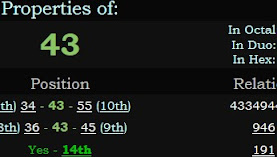The consecutive integers 10 and 11, and their prime relationships [(10, 29) and (11, 31)] are significant to the final score of this year's Super Bowl.
- The final score to Super Bowl 55 was 31-9.
- 55 is the 10th Fibonacci number.
- The 10th prime number is 29.
319 + (29) = 348
- The final score to Super Bowl 56 was 23-20.
- L.A. scored 23 points.
- The 23rd prime number is 83.
- The 83rd prime number is 431.
- 348 is the number to which 83 must be added to reach 431:
348 + (83) = (431)
- 29 + 31 = 60
- 60 is the number to which 23 must be added to reach 83:
60 + (23) = (83)
(Consider also that 23, 29 and 31 are consecutive primes)
- The total points scored was 23 + 20 = 43.
- 43 is the 14th prime number.
29 is the number to which 14 must be added to reach 43:
29 + (14) = (43)
- 23:20 is 11:20 on the twelve-hour clock.
The 11th prime number is 31:
- 20 is the number to which 11 must be added to reach 31:
20 + (11) = (31)
The 56th prime number is 263:
- 1120 - 263 = 857.
- 857 is the 148th prime number.
- The 43rd prime number is 191.
- 148 is the number to which 43 must be added to reach 191.
148 + (43) = (191)
- The largest single-day point gain in the Dow's history was 2113 points on March 24, 2020.
- The final score to Super Bowl 55 was synchronized with the 2113 point gain.
- 2113 is the 319th prime number.
- The final score to Super Bowl 55 was 31-9.
- Super Bowl 55 took place on the 38th (the reflection of 83) day of the year.
- The 38th prime is 163.
- 125 is the number to which 38 must be added to reach 163.
- Super Bowl 56 took place 691 days after the 2113 point gain.
- 691 is the 125th prime number.
- The final score to Super Bowl 56 was 23-20.
- 2320 - 2113 = 207
- The 56th prime is 263.
- 207 is the number to which 56 must be added to reach 263.
207 + (56) = (263)




